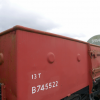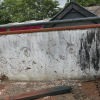Overseer
Western Thunderer
One of the wagons on my informal build list has been the BR HYFIT based on a LNER design. BR built quite a few thousand in the early 1950s to several diagrams. The characteristic feature of these wagons were the pressed dimples in the body sides to make space for rope rings to be fixed inside the body without reducing the available space. I had been thinking about all sorts of complex methods to form the dimples but decided over the weekend to do a quick trial with a simple press tool. The tests were promising so I cut out a few pieces of 0.25mm brass and this is the result so far -


I think it captures the look of the prototype dimples.
This is the simple tool in pieces. Two scrap pieces of 3mm thick brass had three holes drilled, all 3mm diameter except for one 4mm diameter in the bottom plate. Two studs were cut from some 3mm did silver steel rod and a longer piece cut to be the punch. The shape of the end of the punch does make a difference, too sharp and it will tend to cut through the brass instead of deforming it, so round the edges off slightly. The short studs were fixed into the bottom plate with Loctite 601 (not critical) so they didn't get lost. Sorry if the unfinished edges cause offence but the tool only had to form 12 dimples. I use a small press to apply the pressure but a hammer would do just as well. The final refinement was a piece of brass tube cut to length to provide consistent depth to the dimples, only about 0.6mm.
The simple dimple press tool in pieces -

And assembled with a piece of brass in place. I marked the centres of the dimples and set up the position by eye but it would be easy to add some guides to ensure consistency.

And the depth control tube in place -


The wagon will end up as a Diagram 1/041 HYFIT, probably with RCH brakes though I might do one with 8 shoe clasp brakes.


I think it captures the look of the prototype dimples.
This is the simple tool in pieces. Two scrap pieces of 3mm thick brass had three holes drilled, all 3mm diameter except for one 4mm diameter in the bottom plate. Two studs were cut from some 3mm did silver steel rod and a longer piece cut to be the punch. The shape of the end of the punch does make a difference, too sharp and it will tend to cut through the brass instead of deforming it, so round the edges off slightly. The short studs were fixed into the bottom plate with Loctite 601 (not critical) so they didn't get lost. Sorry if the unfinished edges cause offence but the tool only had to form 12 dimples. I use a small press to apply the pressure but a hammer would do just as well. The final refinement was a piece of brass tube cut to length to provide consistent depth to the dimples, only about 0.6mm.
The simple dimple press tool in pieces -

And assembled with a piece of brass in place. I marked the centres of the dimples and set up the position by eye but it would be easy to add some guides to ensure consistency.

And the depth control tube in place -


The wagon will end up as a Diagram 1/041 HYFIT, probably with RCH brakes though I might do one with 8 shoe clasp brakes.








